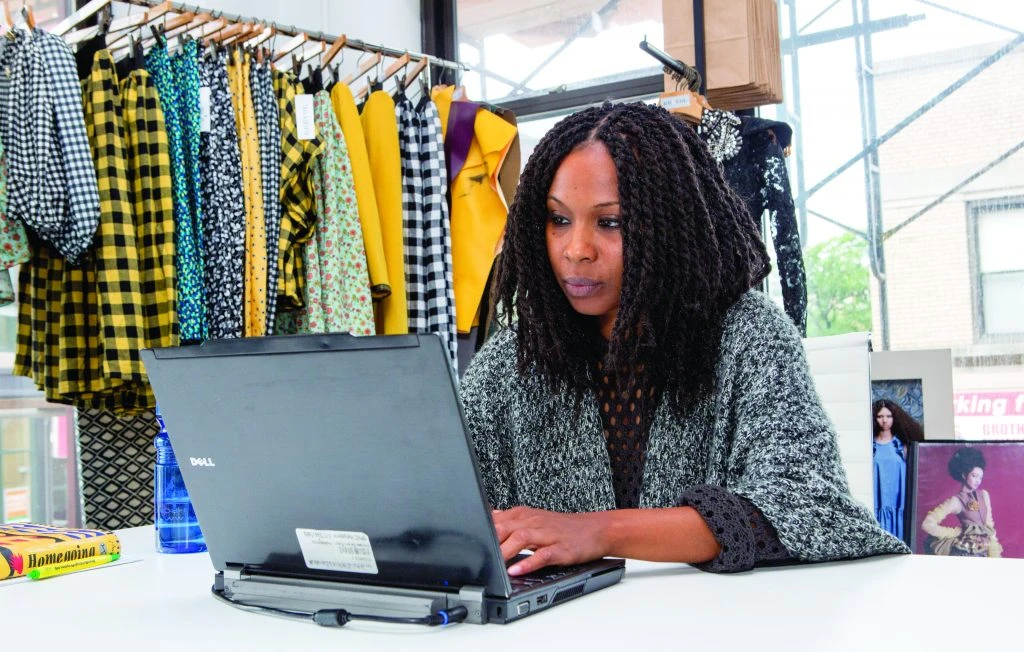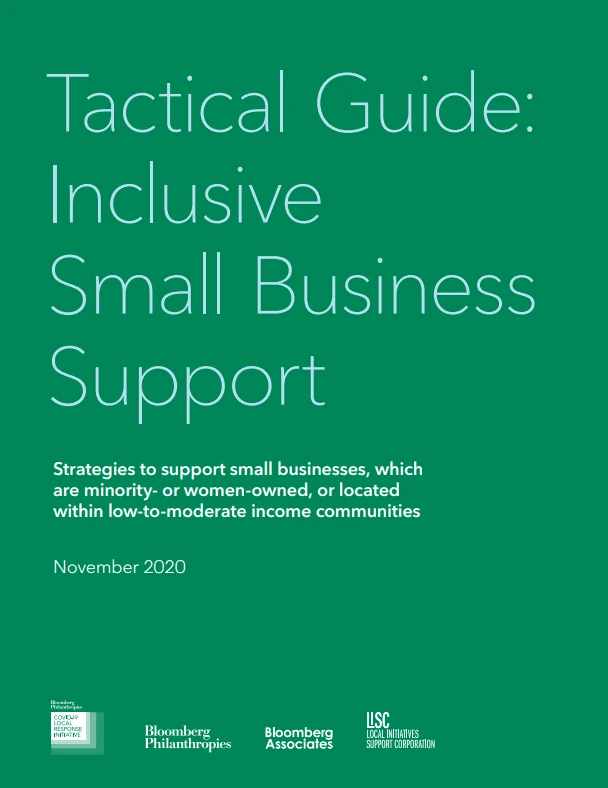COVID-19 Economic Response and Recovery
Retool Incentives to Support Small Businesses
Action:
Retool existing incentive programs to (1) include small businesses and (2) support the hiring of local residents, particularly those with barriers to employment.
Why:
Small businesses are being disproportionately impacted by this crisis and often do not qualify for incentive programs, due to minimum requirements on investment and jobs created. By opening incentive programs to smaller firms, cities can support local businesses through the recession and advance other policy goals (e.g. workforce, equity, living wage, etc.).
Case Study
Business Expansion Incentive Program – Austin, TX
The City of Austin has experienced two decades of rapid growth and expansion, which has led to challenges around equity and inclusion. In 2018, the City adopted new guiding principles, which put “equitable prosperity, opportunity, and affordability” at the center of the City’s economic development policy. The City retooled its incentive programs to align with this policy, prioritizing small and local businesses, hiring residents with barriers to employment, and paying a living wage.
Austin’s Business Expansion Incentive Program offers three types of assistance:
- Local Austin Business: Offers up to 3% wage reimbursement per job/per year maxing out at $1,800, and up to 50% property tax reimbursement. The incentive is available to all registered Austin businesses, which pay Austin’s living wage.
- Targeted Hiring: Provides $3,000 per target job/per year and up to 50% property tax reimbursement for the creation of 1 job in targeted populations or for residents who have barriers to employment, and pay Austin’s living wage.
- Relocating: Offers a 3% wage reimbursement per job/per year maxing out at $1,800, and up to 50% property tax reimbursement for businesses new to the city and creating 75+ jobs over 10 year paying Austin’s living wage.
While still open to larger and relocating employers, typical of most incentive programs, the City’s Local Austin Business and Targeted Hiring programs have eligibility criteria designed to allow smaller, local businesses to qualify for these incentives. Program elements include:
- All incentive projects are evaluated by staff using a cost benefit analysis to determine fiscal impact. Importantly, to ensure smaller local firms can qualify, the City does not require the project to have a net revenue positive impact for the City, but it must be revenue neutral.
- Austin uses a return on investment calculus, which includes a broad definition of community benefits such as development and hiring underrepresented groups; demonstrating diversity, inclusion, and equity practices and policies; neighborhood connection; local partnerships; sustainable business practices; and civic engagement.
- The City provides bonus qualifiers for small businesses, cooperatively owned businesses, businesses, which engage local music and arts community, and businesses that provide on-site day care.
- All three incentives require that qualifying jobs must pay the Austin living wage of $15 per hour.
- All grants are performance based and quality controls include a third-party audit system.
- While most incentive projects must be approved by the City Council, the Economic Development Department is able to negotiate and award incentive deals up to $61,000 per project for a total up to $5 million per year.
Small businesses and MWBEs have benefited from the City’s new individualized focus on smaller incentive deals.
For example, a local minority-owned restaurant, L’Oca d’Oro, agreed to retain 20 individuals over 5 years from the program’s targeted population, and make 10 new hires. In return, the restaurant receives $2,000 annually on a declining basis for each retained employee and $220 per year for each new hire.
Another minority-owned firm, AllPro Hospitality Staffing, committed to creating 10 new jobs under the targeted hiring incentive.

How to Adapt This Approach:
- Review past outcome data to assess the effectiveness of current incentives in advancing inclusive goals
- Engage a diverse set of local business groups, merchant associations, chambers of commerce, and other community stakeholders to determine potential changes to current incentive offerings or identify the need for a new incentive program
- Develop proposed modifications to existing incentive programs, which align with the City’s broader equitable economic development strategy/recovery plan. These modifications could include:
– Opening existing programs to local small businesses
– Targeting incentives to businesses located in LMI neighborhoods
– Incentivizing the hiring of residents with barriers to employment
– Supporting businesses investing in upskilling of existing employees - Revise eligibility requirements to align with these modifications (e.g., reducing new job creation/ retention minimums, reducing investment requirements, reducing the complexity/legislative requirements for incentive approval, setting a neutral fiscal impact standard, including a broader set of community benefits in return on investment analysis, etc.)
- Conduct analysis to model the potential uptake of the modified incentives and assess potential fiscal impact
- Share proposal with stakeholders and incorporate feedback
- Articulate policy case for the proposal to policy makers and secure approval
- Partner with merchant associations, local/ethnic chambers, and other community groups which are trusted partners in the communities, to drive outreach and promote the modified incentives.
- Track and publish KPIs on a regular basis. Include impact, demographic and neighborhood data on each incentive project. (See KPIs section)
Learn more about the Tactical Guide
COVID-19 Economic Response and Recovery
Redesign your Business Attraction, Expansion and Retention Incentives

During an economic downturn, you should consider refocusing the financial incentives that were used to recruit new businesses, such as tax breaks, attractive loan financing and grants, to support retention and expansion of existing businesses.
Examples of US Financial Incentives Include:
- Industrial development bonds
- HUD CDBG revolving capital fund
- EDA loans
- Revolving capital fund
- SBA 504 loans
- Restoration tax abatement
- Business retention and modernization tax credits (e.g. payroll, sales/use, investment, clean energy)
- FastStart/on the job/incumbent worker training program
Source: Georgia Institute of Technology, 2010
Learn more about Business Retention Strategies
Action:
Support local incubators or makerspaces, which offer affordable rents, flexible terms, shared equipment and services, room-to-scale operations, networking events, and communities of peer entrepreneurs.
Why:
Such projects can be catalytic, helping entrepreneurs create businesses and existing businesses to grow, thereby building local wealth. By establishing and preserving affordable spaces for light manufacturing, business incubation, maker/artist studios, and cultural activities, cities can foster quality middle-skill job opportunities for LMI residents.
Case Study
East End Maker Hub – Houston, TX
Urban Partnerships CDC (UP CDC), a nonprofit real estate development company, partnered with TXRX labs, a nonprofit high tech maker space, to develop the East End Maker Hub in a historically marginalized part of Houston with a majority Latinx population.
It offers 300,000 square feet of multi-tenant, multiuse manufacturing and fabrication space, which supports makers, manufacturers, corporate tenants, and other small businesses. It features multiple spaces of varying sizes to target manufacturers and makers looking for affordable long-term rents, collaborative space, and access to equipment.
The hub was funded by HUD Section 108 and CDBG grants, which the project procured from the City. UP CDC also procured an EDA grant. The project received a New Markets Tax Credit allocation through the People Fund, Urban Research Park and McCormack Baron Salazar and also received support from LISC, a CDFI.
TXRX labs, Houston’s largest manufacturing business incubator and accelerator, is the anchor tenant of the East End Maker Hub. TXRX provides access to over $2 million worth of machinery and equipment, classes, and technical support, job training programs.
It focuses outreach on minority-owned manufacturers, makers, and other small businesses located within a three-mile radius of the building. It also sees its role as supporting wealth building in the local community.
As part of TXRX’s Youth Education program, its staff speak at local community events and give presentations at local churches and schools. They also build relationships with local teachers to help them understand the role of manufacturing as a pathway to middle-income jobs. Further, they encourage the students to visit the hub and participate in afterschool programs. Each year, the hub provides job training for 75 adults and hands-on learning for over 500 teenagers.
The hub is projected to have an annual economic impact of $153 million and create 400+ direct and 200+ indirect jobs.

How to Adapt This Approach:
- Identify and support local CDCs and CDFIs with a mission to support local manufacturing/ makers/entrepreneurship
- Engage local communities, entrepreneurs and neighborhood groups, to involve them in the project
- Help them to secure HUD Section 108 funding, New Markets Tax Credits, and other government funding to purchase/renovate a disused/underutilized building in a disinvested neighborhood
- Support land-use changes to facilitate the project
- In pre-development planning and space considerations, strike the right balance between creating a workplace and community asset that contributes to placemaking
- Plan to open doors to the public and forge ties with the local community, catalyzing public understanding of the importance of industrial spaces
- Support community-based organizations providing programs and services to local businesses
- Connect City/regional workforce training and placement programs and prioritize local hiring
Learn more about the Tactical Guide
COVID-19 Economic Response and Recovery
Rebuild Traveler Confidence in your Destination
Action
Implement a widely recognized COVID-19 safety compliance certification program for tourism and hospitality businesses, and communicate it widely.
Provide a flow of easily accessible, digestible, accurate, and timely information and facts about the state of your destination. Be open to answering questions to inform travelers’ decision-making.
Why
With visitor number levels down, many destinations cannot afford to alienate travelers, which can now demand more stringent cleaning and safety protocols. Destinations which have implemented recognized health and hygiene protocols will be better able to position themselves as safe, and increase travelers’ (particularly baby boomers) confidence.
However, the implementation of a “gold standard” certification program is not, in itself, sufficient. Destinations also need to be transparent in their communications if they are to spur demand. In particular, they need to communicate detailed, trustworthy information about cleanliness and health measures through regular updates from trusted sources.
Background
Many leading destinations have launched recognizable certification programs to strive for a consistent approach to safety. For example the Singapore Tourism Board, Visit California and Cape Town Travel.
These programs often draw on the World Travel and Tourism Council’s SafeTravels program, which sets out detailed protocols for hospitality, retail, attractions, meeting venues, and car rental companies, amongst others.
Case Study
Austin’s Dine with Confidence
A volunteer-led coalition of business owners, known as Good Work Austin, created a program called Dine With Confidence in response to the state’s more lax COVID guidelines, which became a “bill of rights” for diners and restaurant workers.
The goal was to build consumer confidence, keep workers safe, and prevent restaurants from closing. The coalition set strict protocols around social distancing, sanitary measures, mask mandates, and other measures. It was their hope that the city would endorse the measures.
It then asked local businesses — fine dining restaurants, counter-service spots, coffee shops, and businesses that were only open for take-out — to sign the pledge.
The pledge requires businesses to:
- Add notes to websites and reservation sites stating that guests cannot enter if they are exhibiting any symptoms of COVID-19
- Engage a medical professional to counsel employees on safe behaviors, both at work and away from work.
- Require employees to complete a health declaration to make sure they are not putting community members at risk
- Take staff temperatures daily and send home anyone with a 99.6º, or higher temperature
- Require staff who have experienced COVID-19 symptoms to remain at home until they can 1) receive a doctor’s note allowing them to return to work; 2) receive a negative result from a COVID-19 PCR test; 3) complete a 10-day self-quarantine
- Require staff, who were in close contact (within 6 ft for more than 15 mins) with an employee who tests positive for COVID-19, to quarantine for 7 days, and then obtain a negative PCR test
- Provide all staff with access to health care and paid sick leave
- Require all dine-in or other unmasked customers to provide their names and complete a Health Declaration
- Require all staff to wear masks while in the establishment. Require guests to wear masks, unless specifically excepted for active dining, or receiving other services that require them to be unmasked
- Enforce hand washing every 30 minutes for all staff
- Prevent staff from having any intentional physical contact, and make them constantly aware of the necessity of social distancing
- Dedicate certain employees to service guests and/or divide spaces and redefine roles to further separate employees and guests
- Make menus and similar information items online, display, single-use, or sanitize them after each use
- Place hand sanitation stations at the entrance and exit of the establishment and outside the restrooms
- Ensure proper ventilation of indoor spaces by cleaning and changing MERV13 filters monthly. Perform preventive maintenance quarterly for HVAC systems. Identify other measures to increase air flow
- Adopt all elements of the “Open Texas Minimum Standard Health Protocols” for facility, employees, and guests.
When creating the list, the coalition surveyed businesses to find out what they needed and what challenges they faced. It then purchased PPE in bulk and at lower cost. It also sourced architects, who offered pro-bono advice on safe dining formats. Where possible, the coalition drew on CDC guidelines. Where this was not available, it drew on local authorities and experts. The pledge was promoted to businesses and patrons through press and social media. 50 local businesses signed the charter, and numerous towns and cities from Raleigh, NC, to San Diego, and the Hudson Valley, asked for guidance to replicate it.

How to adapt this approach
Identify industry representative bodies or leaders, with local influence and reach into businesses which/who can front the program.
Work with CDC and local health officials to develop measures which both meet high standards and will satisfy anxious residents and visitors.
Develop guidance which is specific and unambiguous. Monitor and call out breaches.
Engage a wide range of businesses about the measures to understand their adoption challenges. Work with the businesses to identify solutions. Communicate the measures widely and encourage residents and visitors to share their experiences.

Do
- Do make safety measures specific, and try to secure broad adoption across a customer’s end-to-end journey.
- Do engage city officials early in the process to seek their buy-in, help coordinate and extend measures across industry segments, and communicate them to residents and visitors.
- Do encourage local businesses to raise awareness of local safety measures with residents and visitors, because first travelers can validate destinations’ communications and spread the word to family and friends that they would have the confidence to return. (92% of travelers say that they trust word-of-mouth recommendations from family and friends.12)
- Do focus communications on relevant social media channels and online forums. Since the pandemic, travelers have placed greater importance on pre-trip planning, and Pinterest has emerged as a popular platform.13 Almost half of all travelers have also increased their time spent browsing social media, and many rely on online travel forums to find information about how destinations are executing on safety.14
Don’t
- Don’t activate tactical marketing too early. Multiple surveys show that travelers will not visit your destination unless they are confident that they can do so safely. Action 3 contains advice on ways to build their confidence.
Learn more about the Tactical Guide
Action
Create a task force of no more than 12 people with specific skills and experience who can speak on behalf of your tourism and hospitality industry, with a particular emphasis on local, small businesses.
Why
The pandemic has highlighted the importance of cooperation between governments, destinations, and business.
To rebuild traveler confidence, destinations must be able to demonstrate visitor safety across the end-to-end journey, which requires all players to adopt a coordinated approach.
Moreover, as the tourism sector comprises mainly micro and small businesses, there is a clear role for governments and DMOs to use their convening power to help local businesses work together and be heard by policy makers.
Case Study
One Industry One Voice
The UK One Industry One Voice coalition is a weekly taskforce of events industry associations and businesses, led by umbrella trade organisation “The Business Visits and Events Partnership” — which represents the conference, exhibition, and outdoor events sector.
The coalition is supported by eight other industry associations including “UK Live Music Group”, which represents the UK’s live music industry, and events and entertainment technology trade association, “The Professional Lighting and Sound Association.” It is also supported by London’s DMO, London & Partners, which operates the city’s tourism and convention bureaus.
The taskforce was created following an informal meeting organised by an event management company in July 2020 to coordinate the communications being developed to support the industry.
It has 4 objectives:
- Coordination of campaign timings
- Consistency of data and statistics about the industry
- Alignment on asks and communication to government
- Amplification of key messaging and mutual support to promote campaigns activities.
The taskforce took time to build trust and find ways of working, as well as understand and agree on the key issues facing everyone who works in the events industry.
It established working groups on COVID testing and insurance issues, where the focus was on sharing of information and ideas, as well as understanding where conversations were taking place within different government departments.
It also created a website, which contains base line numbers for the industry that were used across all campaigning activity — from the economic value that the industry delivers, to the number of people employed across the event industry ecosystem. The website also contains a diary function to allow people to share key dates and activations to support the scheduling of communications and messaging. Further, the taskforce launched a quarterly survey into the state of the industry. This was used for campaigns and shared with associations, so that they could use it in their own lobbying and campaigning activity.
The taskforce’s lobbying campaigns have included # We Create Experiences, # What About Weddings, and # Save Nightlife.
How to adopt this approach
Keep the task force agile, focused, and responsive. It should consist only of people with the skills, experience, and connections needed to get the job done.
There should be a regular cadence of meetings with clear tasks beforehand and afterwards.
Focus the task force on specific, practical projects which will produce a particular result.
A government or DMO official should connect the task force to municipal, county, state, and federal decision makers.
The task force should operate transparently, providing regular updates to businesses, sharing trusted information and advice, and creating opportunities for businesses to support its goals.

Do
- Do gather compelling data on the industry’s importance to the destination, as well as the impact that the pandemic has had on local businesses and workers. For example, prior to the pandemic, New York’s Hudson Valley collected data which found that tourist activity supported multiple sectors of the economy, sustained $38bn total income, reduced the unemployment rate from 12.5 to 4.1%, and saved every household an average of $1,221 in taxes.
- Do make things easier for stretched public officials — becoming a single point of contact to understand industry wants and needs, a way to communicate to the industry, and a partner to get support to the businesses and workers who need it most.
- Do accept that different segments of the industry may have different priorities and focus the task force on common goals — but not on the lowest common denominator.
Don’t
- Don’t try to maintain the task force beyond its useful life, and don’t ask it to solve every challenge facing every segment. Remember that it is a temporary grouping for the purpose of accomplishing a definite objective.
To find out more

COVID-19 Economic Response and Recovery
Refresh your business attraction sector propositions and collect lead generation insights
While opportunities to attract businesses to your city will be significantly reduced during an economic downturn, there may still be opportunities, either in industries that are seeing a demand surge or are being restructured.
Revisit your sector propositions and update your commercial real estate database (assessed value and taxes, last sale date and amount, availability for sale or rent, total square footage, amenities, zoning classes, historic status, condition, current tenants) for a post-pandemic economy.
Also, maintain relationships with industry leaders, “multipliers” (such as professional services firms, and real estate brokers) and site selectors; and/or get early intelligence from investment attraction platforms, such as ROI Gazelle, Conway Analytics, or FDI Markets with investor signals.

Learn more about Business Retention Strategies
COVID-19 Economic Response and Recovery
Provide Access to Funds and Resources for Tourism Businesses to Adapt
Action:
Provide access to finance and technical assistance to help small, tourism and hospitality businesses pivot, adapt, and capitalize on new demands and opportunities in a postpandemic world.
Why:
Keeping local, small businesses is critical for the recovery of your tourism economy. By helping them develop new online communications and sales channels, create new lines of business, or repurpose and adapt their space, you are helping to create longterm revenue solutions.
Background:
In 2020, U.S. travel spend declined by nearly $500 million and, while the industry improved between April and September, progress stalled in the final quarter of the year due to the continued absence of business travel and another surge in COVID-19 cases.
The travel economies of every city and state were affected. Seventy percent of U.S. metropolitan regions have at least 10% of their workforce in leisure and hospitality, and during 2020, cities in more than 18 states experienced 40+% downturn in travel spending. The impact was felt most by small businesses (with fewer than 500 employees), which make up 99.5% of the tourism sector and 60.6% of employment within the sector. Many of them face a time of extreme liquidity strain and most of them entered the pandemic with very limited cash flow.
Women and minorities have also been hard hit, with women- and minority-owned businesses comprising 63.5% of U.S. accommodation and food services businesses and 46.5% of arts and entertainment businesses.
Given that COVID-19 will probably be around for a long time, many tourism businesses will need to adapt and/or reinvent themselves for “the new normal.”
Case Study
Bellville Downtown District Marketplace
Belleville is a town located between Toronto and Ottawa in Canada. During Canada’s strict lockdown in 2020, the Downtown Belleville Improvement Area (a business improvement district) decided to embark on a project to create an online marketplace called the Downtown District Marketplace.
In just four weeks, the BID launched a website which allowed nearly two-dozen businesses to receive orders for curbside pickup. Today, the website hosts over a thousand products from local businesses, including restaurants, artisan markets, art associations, and galleries. It has attracted more than 50,000 visitors and over 1,000 orders. In fact, the marketplace has been such a success that the BID is no longer supporting it with grant funding.
The BID is currently developing the site to add shipping. Currently, customers can pick up curbside, or merchants manage deliveries themselves.
How the marketplace works
The BID created the marketplace on the Shopify platform. The platform charges the BID $299/month, plus $10/month for a multi vendor marketplace app, which means the BID does not become the merchant.
The BID was fortunate to have two young staff members with the technical skills needed to design a website. They created pages for each local business, which only they could access and edit.
Shopify collects the money from the sales, and the BID pays its merchants every 2 weeks. Each local business is responsible for paying credit card and transaction fees. The BID doesn’t take any commission. The local businesses greatest concern about the marketplace was payment terms. Early on in the project, the BID spent many hours sorting out payments to the local businesses, but it has since managed to automate this process.
Launching the marketplace
The BID launched the marketplace with a teaser campaign, which included VIP access to the first 250 people that signed up for its newsletter. In this way, it was able to gather feedback on issues that early users faced and make adjustments before opening to the general public.
Its subsequent marketing tactics have included social media (paid and organic), digital advertisements, local radio, and press releases sent to local and national media outlets. Local partners have also provided content and written features for the Marketplace.
The BID did not receive support from the city to launch the Marketplace. It did, however, receive funding from a regional marketing board to run a contest on the website — users who spent $50 could win Marketplace gift cards to use on their
next purchase.

How To Adopt This Approach:
The project’s success was based on strong relationships with local businesses
1. Assemble and train a group of 5–10 local business owners, who will become
your ambassadors to get other merchants on board
2. Regularly engage business owners and provide sufficient training about the sales platform, recognizing that different business owners have different levels of digital literacy. This will mean creating step-by-step guides, complete with screenshots on how to add products and make payments
3. Help merchants to become confident selling online. Just as a shop needs an attractive window display, a website needs beautiful photos. Merchants will also have to do their own marketing to drive traffic from their website to the Marketplace, for example, by posting and buying advertisements on social media.

Do:
- Do spend time building the trust and confidence of your member businesses.
- Do regularly engage with your business owners and provide support based on their differing levels of digital literacy.
- Do set aside considerable time at the beginning to sort out payments from Shopify to vendors.
Don’t:
- Don’t assume any knowledge. Create stepby- step guides, and share information on how businesses can take good photographs, buy ads, and market their businesses on social media.
Learn more about the Tactical Guide
COVID-19 Economic Response and Recovery
Support Mainstreet/Downtown Businesses by Increasing Local Tourism
Problem:
The COVID-19 pandemic has dramatically altered tourism and travel across the world. Because of these new circumstances, cities can now capture some of that spend locally.
Action:
Cities/ tourism bureaus should launch a PR and targeted advertising campaign to encourage patronage of local businesses. Disinvested neighborhoods and hard-hit industries should be prioritized.
Case Study
New York, NY: NYC & Company Local Tourism Campaign
After the 2008 financial crisis, New York City’s hospitality industry was facing a crisis. Tourism had declined to record low levels and models accurately predicted that business travel and international visitors would be slow to return. This presented a unique challenge for a city that serves as an international tourist and business hub.
To address this, NYC & Company – the City’s destination marketing organization (DMO) – launched a campaign to encourage local tourism. One element was a media campaign to encourage local tourism. The DMO targeted people living in the five boroughs and surrounding neighborhoods to encourage them to visit local attractions and do “staycations” in local hotels. Their communications team also launched promotions of local restaurants and attractions, and showcased examples of New Yorkers enjoying their staycations. Because of a limited budget, the team focused on earned media. It developed contacts at local TV stations and established recurring Friday programming highlighting new places to explore. The marketing team also enlisted prominent residents to promote local establishments and developed content that it could provide to media organizations and through social media channels. The program was successful; there was an increase in room demand and occupancy rate in spring 2009, which was driven by local residents. The business travel market stayed depressed for at least 12-16 months and it took even longer for international travel to return.
Hotel stays were just one element of the organization’s strategy. It also encouraged residents to try local neighborhood restaurants and to explore the many attractions that NYC has to offer.
NYC & Company is currently applying its learnings from the 2008 crisis to develop a roadmap for reopening the city, called All In NYC. The initiative builds on the exploration and staycations promoted in 2008 and prioritizes “Hyperlocal Exploration”, including a Five-Borough Public Art Program. It is also creating “Welcome Back” content which shows how businesses are reopening safely, in an effort to restore consumer confidence.
How To Adapt this Approach:
- Identify local communities that have disposable income (e.g., suburbs, surrounding regions, and states)
- Try to bring on board a local digital marketing agency, which might be willing to work for free/at a discounted rate in exchange for local brand recognition
- Brainstorm marketing campaigns to encourage local “stay-cations” and short getaways. Focus on your audience’s needs and wants and structure the campaign around 5 questions: “what, who, why, where, and when”
- Develop a content plan, which will appeal to your target audience’s needs and wants
- Include a focus on less obvious attractions and neighborhoods. These can include walking tours of famous places (e.g., history, civil rights), visits to ethnic restaurants, and shops that offer local artisan goods
- Develop creative ways to tell local stories
- Launch the campaign with dedicated funding
- Focus all marketing spend on mobile, social media
- “Earn” (do not buy) time on regional publications and media. Try to bring on board a local PR agency, or former journalist with experience pitching stories to the media (and not just writing press releases). Again, negotiate a discount in exchange for local brand recognition and/or access to local business development opportunities
- Attend virtual (or in-person) community gatherings to offer suggestions for safe ways to “explore your city”
- Include a “featured neighborhood” of the week/month, with suggested restaurants, attractions, etc.
- Create a list of top restaurants by cuisine for each neighborhood in the city
- Work with local business leaders to offer incentives to residents who live within a certain distance
- Track reach, engagement and influence, and revise tactics as necessary.

Benefits:
- Facilitates additional spending at local businesses during a time when people are not traveling as much
Risks:
- Spending will just be redistributed within the city, rather than be additional
- Many city-backed marketing campaigns are poorly targeted, executed or measured
Impact: Medium
Implementation time: Slow
Cost: Low. This primarily is leveraging existing media and advertising resources to promote local neighborhoods.
Learn more about the Tactical Guide
COVID-19 Economic Response and Recovery
Provide Technical Assistance to Small Businesses
Action:
Create strategies and partnerships that will make your destination more sustainable and inclusive. And tell that story to visitors
Why:
Since COVID-19, travelers, particularly younger travelers, have a heightened awareness of environmental sustainability and social and racial equity. As a result, they are more likely to look for evidence that destinations are taking steps to address these issues.
Background:
Numerous reports and studies have found that the pandemic has reinforced, even accelerated, people’s views on sustainability, with more consumers focused on helping to create a better, healthier world.
For example, 60% of travelers say that their future booking decisions would be influenced by sustainable initiatives at the property, even if it meant spending a modest premium.
Travelers’ behavior, loyalty, and values are also being redefined by the economic downturn, restrictions in day-to-day living caused by COVID-19, and flashpoint events highlighting systemic racism within our communities.
It is widely expected that the pandemic will accelerate the trend of travelers seeking “travel with a purpose,” with 67% of recently polled travelers saying they want their bookings to make a positive difference for communities affected by the pandemic.
Travelers are also now placing greater importance on pre-trip planning.
Destinations can respond to these trends by developing a shared understanding of what it means to be a sustainable destination.
For example, Sedona, AZ engaged the Global Sustainable Tourism Council to conduct a sustainability assessment of its tourism economy.
The goal was to enable the destination to design and target policies, programs, and campaigns which demonstrate sustainable destination management, maximize economic benefits to the host community, and minimize negative impacts on the environment.
Programs could include:
- Sector-wide sustainable guidelines.
- Technical assistance to small businesses to help them adopt more sustainable practices (e.g., relating to energy and water use, single use plastics and recycling, food procurement, laundry operations, and reporting).
- Destination management tools to “nudge” visitors around the city, to manage crowds, and/or to help tourists engage local communities.
- Investments in green infrastructure.
- Communicating the destination’s commitments to travelers.

Case Study
City of Boston
In 2020, the City of Boston drew down $2.5M of CARES Act Federal relief funding to launch a marketing campaign to market the city to Black and Brown residents and visitors.
The campaign’s goals were to “build Boston’s brand as a travel destination, increase awareness and active promotion, and drive visits to Boston from diverse local and regional visitors.“ It was part of the city’s strategy to build back a stronger and more equitable economy.
In particular, the campaign sought to “examine the ways in which Boston communicates about the offerings of the city, and highlight attractions and events that speak to the experiences of people of color.”
The Greater Boston Convention & Visitors Bureau selected two award-winning agencies with deep roots in the city. One was Boston’s oldest, minorityowned and operated marketing communications agency. The other was a Boston-based, minority owned, award-winning creative branding, design,
and advertising agency.
They soon discovered that the city had allowed others to create a narrative of Boston as an all white, masculine, sports- and alcohol- dominated city. Visitors and some residents had low awareness of the city’s vibrant Black neighborhoods, and the contributions of Black and Brown residents to the city.
The campaign featured different Boston neighborhoods with neighborhood maps and guides and short-form videos, as well as social media influencers from some of the city’s oldest Black neighborhoods. It also celebrated Black and Brownowned businesses in local and national media, in order to drive local spend.
Like many campaigns during the pandemic, its primary audience was local residents. However, as travel becomes safer, the city plans to continue its efforts to encourage a wider audience to change their perceptions and, ultimately, actions.
Learn more about the Toolkit
COVID-19 Economic Response and Recovery
Maximize federal funding sources by using new markets tax credits (NMTC), which are available for a wide range of applications
Action:
Cities should partner with Community Development Entities (CDEs) to access New Markets Tax Credits (NMTCs) to fund real estate developments.
Why:
NMTC investments can fund catalytic development projects in low- and moderate-income communities. By partnering with a CDE to access NMTCs, cities can attract third-party funding that might otherwise have had to come from the general fund.
Background:
NMTCs can be an important source of funding for businesses and community facilities in distressed urban and rural communities. Individual and corporate investors can receive a 39% tax credit (taken over seven years) for qualified investments into CDEs. CDEs can then use the proceeds of those investments to fund business expansions, community facilities, and other community projects.1
The project owner makes annual interest payments to the CDE during the seven-year life of the loan structure, eventually closing out the transaction at a substantial discount.
Examples of NMTC-funded projects include:
- Business expansions: $10 million NMTCs contributed to the construction of a $13 million, twin bay airplane paint shop, as part of a $22.36 million investment in an Airbus facility in Mobile, AL.2
- Infrastructure improvements: NMTCs contributed to the conversion of a vacant mall into a 750-car parking garage and retail/ entertainment complex in St. Louis, MO.3
To become certified as a CDE, an organization must submit a CDE Certification. Application to the Department of the Treasury CDFI Fund. The application must demonstrate that the applicant meets each of the following requirements:
- Be a legal entity at the time of application.
- Have a primary mission of serving low-income communities.
- Maintain accountability to the residents of its targeted low-income communities.
1: https://nmtccoalition.org/progress-report-2019/about-the-nmtc/
2: https://munistrategies.com/project_portfolio/maas-aviation/ and https://nmtccoalition.org/project/maas-aviation/
3: https://nmtccoalition.org/project/mercantile-exchange/
A CDE can be a Community Development Finance Institution (CDFI), mainstream financial institution, government/quasi-government, nonprofit, or for-profit. A city government can become a CDE.
The CDFI Fund conducts an annual competition (incredibly competitive) for NMTC allocations. Applications are scored against four criteria: community impact, business strategy, capitalization strategy, and management capacity.
CDEs typically engage a consultant to support their allocation. CDEs that are awarded NMTC allocations sign an allocation agreement, before raising private investment to deploy to appropriate projects. Most NMTC allocations go to CFDIs, followed by mainstream financial institutions, and then governments.4
A benefit of becoming a CDE is the access to unrestricted funding, via received interest payments.
4: https://www.taxpolicycenter.org/briefing-book/what-new-markets-tax-credit-and-how-does-it-work
Case Study
Union City, TN – Williams Sausage Company Expansion
Williams Sausage Company, founded and based in Tennessee, needed risk capital to fund a $48m project, comprising of a 200,000 ft2 production facility, distribution center, truck maintenance shop, and corporate office.
The company engaged a site selector consultant to review 13 sites. Tennessee state, Union City, Obion County, and the Tennessee Valley Authority offered an incentive which included $44m in NMTCs. But for the NMTCs, Williams would have not located at a distressed site in Union City.
The project components included the following:
- Williams employed site selector and incentives consulting firm, HWH Group, which identified funds and helped coordinate the incentive package.
- Five CDEs contributed NMTCs to the incentive package, which also included state and local incentives.
- CDE, Stonehenge Capital (not located in TN), provided $10 million of qualified low-income community investments (QLICIs) to fund the purchase of equipment. This qualified under its allocation agreement as an innovative use of NMTCs.
Impact:
The project created 210 new jobs in a distressed neighborhood. It is also expected to create a further 321 jobs over the next 5 years.
The company is working with local workforce development agencies to train and hire underserved, low-income residents to become technicians and professionals at the facility.

How to Adapt this Approach
- Develop a relationship with local, or even non-local, CDEs, which can apply for NMTCs for priority project(s). CDEs can make investments within their approved service areas. These range from local to national.
- The CDFI Fund website has a mapping tool that shows approved service areas (see example below).
- The CDFI Fund website has a search function that allows you to identify CDEs that have remaining, available NMTC allocation authority.
- If you are a CDE, identify projects that meet your goals and NMTC usage requirements prior to application. Alternatively, propose your project to a CDE which has unused allocation. (The CDFI Fund publishes Qualified Equity Investment Reports monthly. See example report.)
- Work with the CDE to submit an electronic allocation application via the Awards Management Information System (AMIS)
- This “how to apply” report contains detailed advice on how to prepare your application
- Report your compliance via AMIS.

Do:
- Be aware of NMTC application deadlines, which are shared on the Department of the Treasury CDFI Fund website.
- Identify potential projects which are NMTC-eligible. Help projects to become NMTC-ready, through land use approvals.
- Talk with other cities that have successfully worked with CDEs to capture NMTC investment in their community.
- Engage local stakeholders to ensure support for the project.
- Work with existing experienced CDEs:
- Applying for a NMTC allocation is a complex process.
- Most successful applicants are existing CDEs and CDFIs with significant experience.
- Working with the CDE can ensure that your project makes it into its application, or is allocated excess credits
Don’t:
- Don’t go into this process alone, or without advice.
- Don’t partner with only one CDE. Multiple CDEs can invest in the same project.
- Don’t underestimate the severity of “recapture.” While this risk is low if the transaction is structured properly and compliance is up to date, penalties are harsh (100% of the credits can be recaptured with interest and penalties).





